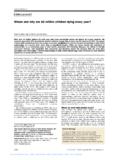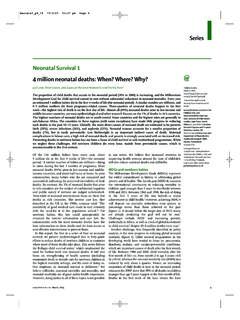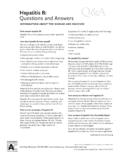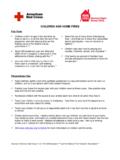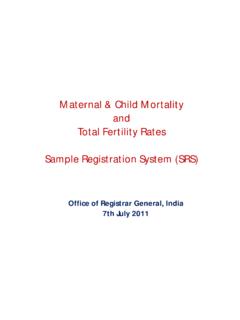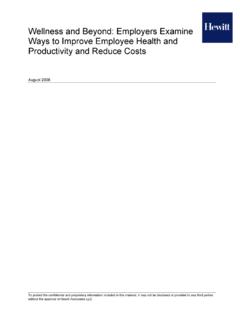Transcription of Africa’s Orphaned and Vulnerable Generations …
1 Africa s Orphaned and VulnerableGenerationsCHILDRENAFFECTED BY AIDSA frica s Orphanedand VulnerableGenerationsCHILDRENAFFECTEDBY AIDSE xecutive summary ..ivIntroduction ..1 CHAPTERSC hapter 1:The scale of the crisis ..2 Chapter 2:Poverty, HIV and children ..10 Chapter 3:Family structures ..14 Chapter 4:The impact of the crisis on children ..18 Chapter 5: Supporting Africa s Orphaned and Vulnerable children ..26 PANELSThe development context for responding to orphans and Vulnerable children ..viPanel : One country s experience ..3 Panel : Definition of orphan ..4 Panel : Orphan estimates ..6 Panel : Within a country, many differences in where orphans live ..7 Panel : One woman s struggle ..12 Panel : Residential facilities for orphan care ..20 STATISTICAL TABLEST able 1: Estimated number of orphans by region, year, type and cause ..35 Table 2: Estimated number of orphans in sub-Saharan Africa bycountry, type, age and cause.
2 36 Table 3: AIDS and other relevant indicators, sub-Saharan Africa ..37 Table 4: Situation of children , sub-Saharan Africa ..38 Table 5: Government response to Orphaned and vulnerablechildren, sub-Saharan Africa ..39 CONTENTSAFRICA S Orphaned AND iiVULNERABLE GENERATIONSCHILDREN AFFECTED BY AIDSFIGURESF igure : Number of orphans ages 0 17, by region, 1990 2010 .. 3 Figure : Percentage of children in sub-Saharan Africa ages 0 17 Orphaned by any cause, 1995 and 2005 .. 4 Figure : Countries in sub-Saharan Africa where approximately 15% or more of all children are orphans.. 5 Figure : Number of children in sub-Saharan Africa ages 0 17 experiencing the death of a parent during the year .. 6 Figure : Number of double orphans in sub-Saharan Africa ages 0 17, AIDS versus all other causes, 1990 2010 .. 6 Figure : Orphaning rates in rural and urban areas .. 7 Figure : Age distribution of Orphaned children in sub-Saharan Africa, 2005.
3 8 Figure : Percentage of children by age at time of parent s death, four districts in eastern and southern Africa .. 8 Figure : Number of children in sub-Saharan Africa ages 0 17 Orphaned due to AIDS, 1990 2010 .. 8 Figure : Distribution of double orphans and non-orphans by household wealth, Kenya, 1998 and 2003 .. 11 Figure : Average dependency ratios among households with and without orphans .. 12 Figure : Average dependency ratios in female- and male-headed households with double orphans .. 12 Figure : Percentage of children ages 5 17 with basic material goods (blanket, shoes and two sets of clothing), Blantyre, Malawi, 2004 .. 13 Figure : Percentage of children ages 5 17 with basic material goods (blanket, shoes and two sets of clothing), 21 districts in Zimbabwe, 2004 .. 13 Table : Living situations of orphans and non-orphans .. 15 Figure : Percentage of maternal orphans ages 0 14 living in a female-headed household.
4 15 Figure : Percentage of double orphans and single orphans (not living with surviving parent), ages 0 14, cared for by their grandparents .. 16 Figure : Percentage of double orphans and single orphans (not living with surviving parent), ages 0 14, by relation to head of household .. 17 Figure : Under-five mortality rate estimates with and without AIDS, 2000 2005, select African countries .. 19 Figure : Percentage of women ages 15 18 with HIV infection, teenage pregnancy or STI symptoms, by status as Orphaned or Vulnerable , Manicaland, Zimbabwe, 2004 .. 21 Figure : Percentage of children ages 10 14 who are in school, comparing non-orphans ( children living with at least one parent) with double orphans .. 23 Figure : Responses of orphans due to AIDS and non-orphans to questions about symptoms of depression, Bushenyi district, Uganda .. 24 Figure : Percentage of children under age five whose birth was registered at the time of the survey (1999 2003).
5 25 Figure : Percentage of Orphaned and Vulnerable children whose households are receiving free external support, United Republic of Tanzania .. 28 Figure : Impact of universal primary education policy on school attendance, 10- to 14-year-olds, Kenya .. 29 Figure : Willingness to disclose HIV status of family member .. 30 Annex:Methods to estimate and project the impact of HIV/AIDS on the number of Orphaned children .. 40 AFRICA S Orphaned AND Vulnerable Generations iiiCHILDREN AFFECTED BY AIDSThe AIDS epidemic in Africa putschildren at risk physically, emo-tionally and economically. Allchildren are indirectly affected whentheir communities, and the servicesthese communities provide, arestrained by the consequences of theepidemic. Nurses, doctors, teachersand others can become ill and die fromAIDS, affecting health care, educationand other basic are directly affected in a num-ber of ways.
6 They may live at high riskof HIV; they may live with a chronicallyill parent or parents and be required towork or put their education on hold asthey take on household and caregivingresponsibilities; their households mayexperience greater poverty because ofthe disease; and they can be subject tostigma and discrimination because oftheir association with a person livingwith HIV. children can also becomeorphans, having lost one or both par-ents to AIDS-related illnesses. In sub-Saharan Africa, AIDS is the lead-ing cause of death among adults ages15 59. Although the total number oforphans from all causes in Asia and inLatin America and the Caribbean since1990 has been decreasing, the numberof orphans from all causes has risen bymore than 50 per cent in sub-SaharanAfrica, where an estimated 12 millionchildren ages 0 17 have lost one orboth parents to AIDS. This makes theregion home to 80 per cent of all thechildren in the developing world whohave lost a parent to the are experiencing the greatestparental loss in southern Africa, whereHIV prevalence rates are 2010, an estimated millionchildren 30 per cent of the 53 mil-lion anticipated orphans from allcauses in sub-Saharan Africa willhave lost at least one parent due toAIDS.
7 Even where HIV prevalence sta-bilizes or begins to decline, the num-ber of orphans will continue to growor at least remain high for years,reflecting the time lag between HIVinfection and experiences of Orphaned and Vulnerable children vary significantlyacross families, communities and coun-tries. Some studies have shown thatorphans and Vulnerable children are athigher risk of missing out on schooling,live in households with less food secu-rity, suffer anxiety and depression, andare at higher risk of exposure to situation is influenced by a com-plex mix of variables, including chil-dren s relationship to their caregivers,the wealth of their household and com-munity, HIV prevalence in the commu-nity and an array of other factors. In almost every country in the region,there are notable differences betweenthe responsibilities assumed by fathersand mothers, with widowed mothersmore likely to be responsible for thecare of their children than widowedfathers, making children who losetheir mothers less likely to live with thesurviving parent compared to childrenwho lose their fathers.
8 Furthermore,the survival of the youngest childrenEXECUTIVE SUMMARYAFRICA S Orphaned AND ivVULNERABLE GENERATIONSCHILDREN AFFECTED BY AIDS(ages 0 3) is at stake when their moth-ers are dying or have recently is true whether the mother dies ofAIDS or other causes. children of thisage group are times more likely todie in the year before or after theirmother s families care for the vastmajority of orphans and vulnerablechildren in sub-Saharan Africa, inmany countries assuming responsibili-ty for more than 90 per cent of all dou-ble orphans and single orphans notliving with the surviving parent. Withina household, the nature of the rela-tionship between the new caregiverand the child strongly influences theoutcome for the child. Several studieshave shown that the closer childrenremain to their biological family, themore likely they are to be well caredfor and the greater the chance thatthey will go to school consistently,regardless of poverty level.
9 While families have cared for theexpanding number of orphans and vul-nerable children in sub-Saharan Africa,in places with advanced epidemics,there is some indication that childrencan end up in poorer households andthat available caretakers are becomingscarcer and more implications of the AIDS epidemicfor Generations of orphans and vulner-able children in sub-Saharan Africa areserious, but governments, internation-al agencies, non-governmental organi-zations and community groups canalter the course of the response. Somechallenges can be addressed by pro-viding support to caregivers, extendedfamilies and communities. Others,including equitable access to educa-tion and health, birth registration, fos-ter care and inheritance legislation,also require commitment and inter-vention from governments. In recent years, there has been a surgein leadership and resources for thefight against AIDS.
10 In 2005, approxi-mately $ billion was available forresponding to the epidemic. While along-needed influx of funds has greatpotential for improving the lives ofmillions of children affected by the dis-ease, the multisectoral nature of HIVresponse makes tracking difficult atthe country level, so it is not knownwhat percentage of this money isspecifically helping Framework for the Protection,Care and Support of Orphans andVulnerable children Living in a Worldwith HIV and AIDS, drawn up in 2004by a broad array of partners, focuseson families, communities, services andgovernments, and on creating a sup-portive environment for children . Mostcountries in sub-Saharan Africa (aswell as a number of countries in otherregions) are now developing nationalplans of action for these implement an appropriate responseat the required scale, however, theremust be sufficient knowledge to under-stand the situation of children affectedby AIDS.










